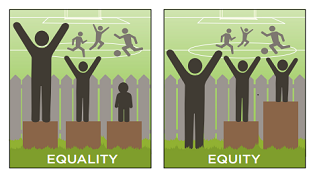What We Mean by Equity at the William Caspar Graustein Memorial Fund

A year ago, our board announced a new mission statement which reads:
After almost a year of reflection and discussion between the staff and the trustees, we have chosen to illuminate the impact of inequity on the educational and life outcomes of people of color along with those who live in low income communities.
As an organization that had not focused previously on these specific issues, we decided to spend our first year or so in exploratory mode: learning more about the dynamics of these issues and how philanthropic strategies and resources could play a constructive role in eliminating barriers and equipping communities affected with the tools, infrastructure and support to overcome racism and poverty. As a part of our internal learning process, we hired a Director of Organizational Culture who would direct our focus on our internal way of practicing philanthropy with the intentional lens of equity that provides an understanding of how the systems of economic and racial injustice and inequality exist and are being reinforced.
Although philanthropy has achieved many great things, abolishing racism and poverty still eludes us and some are learning how philanthropy has been complicit in many ways in the perpetuation of the economic and racial caste systems in our society. Acknowledging that we are not living in a post-racist or post-poverty environment and learning how and why these issues exist today and continue to interfere with the fulfillment of human potential is a fundamentally key and critical part of the work that we are doing in this exploratory period of our work.
As we progress on our journey, our current projects include 1) Learning Conversations around the state where consultants are helping us to solicit the input and feedback of parents, students and other community members affected by racism and poverty, 2) developing our internal Learning Agenda to guide our focus on what we want to learn and how we will do so and 3) issuing Exploratory Grants which will lift up what has worked, is working or may work to reduce or eliminate barriers. Providing clarity around the new concepts which we are working towards for the first time, we have adopted some working definitions as guidance for ourselves and whoever is collaborating with us. In our most recent Request for Proposals (RFP), we explained to our reviewers what we mean when WE say “Equity in Education” with our working definition of equity and how we are applying it to the education arena (which is not limited to the formal education system):
“By equity we mean the just and fair inclusion into a society in which everyone can exercise their individual agency and achieve justice, in order that everyone can reach their full potential. Equity work includes increasing awareness, deepening understanding, and taking actions, particularly at the institutional and structural levels.”
“For purposes of this grant, equity in education refers to learning environments that hold high expectations for every child, from birth to adulthood, and provide whatever opportunities and resources are needed to help reach those goals. Equity in education also acknowledges and actively works against structural barriers that oppress people of color and people living in poverty.”
Although this is not intended as a definitive or thorough definition, this working definition is an important step in developing the lens(es) with which we can be agents and partners in whatever equity work is needed and effective. As we do so, please offer any insights or feedback which you have and wish to share. Learning is neither linear nor easy. Learning requires a willingness and desire to risk, make mistakes, acknowledge mistakes and learn from experiences and knowledge accumulated from others.
As we learn, we want to transparently engage all stakeholders and any partners who share our goals and values. Although there is no guarantee of success, we remain committed to the work, processes and challenges we must face along the way.
A better world awaits!
